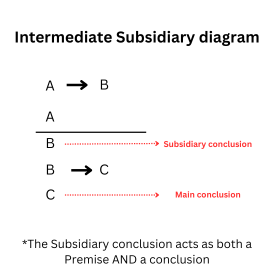Legal Reasoning Quiz 1
1/37
There's no tags or description
Looks like no tags are added yet.
Name | Mastery | Learn | Test | Matching | Spaced |
|---|
No study sessions yet.
38 Terms
Soundness
An argument is sound if its valid and it has true premises
Cogent
An Argument is cogent if it is strong and has true premises
Premise
A premise is made up of propositions ( a statement that can either be true or false)
Validity
An argument is valid when the conclusion folows typically from the premises
Strenth
The More Support there is for the conclusion (More evidence, more cases, more explanations) ; The stronger an inductive argument will be
Deductive Argument
An Attempt to prove a conclusion with 100% certainty
If Premises = True; conclusion must be true.
Inductive argument
Is ampliative reasoning from cases:
The premises do not 100% guaruntee the truth of the conclusion.
What defines an Argument
an Argument = an attempt to prove/convince others of something
An argument always has conclusion + Premises
What defines a set of facts
A set of facts merely provides Info
Premise indicator words
Since
Because
As
For
Given that
Assuming That
The reason that
the view of the fact that
Conclusion Indicator words
Therefore
Thus
So
As a Result
consequently
it follows that
hence
which means that
Which implies that
Intermediate subsidiary conclusion
They are premises that both have premises that support them and in turn provide support for the main conclusion of the argument.

Background Information
Adds context to an argument, but is not itself a part of that argument
Not shown on any diagram.
Its not supported by any premises
It does not provide support for any conclusions
A conditional statement
a basic logical relationship between two propositions telling us that if the one condition is met, then another condition must be met.
How to find the contrapositive
You reverse the order of the sufficient and necessary conditions, and then you negate both sides.
A→ B then becomes [ ~B→~A]
The rule of “IF”
IF always introduces the sufficient condition
The rule of “ONLY IF/ONLY WHEN/ONLY WHERE”
ONLY IF introduces the necessary condition.
The Rule of “UNLESS/EXCEPT WHEN”
UNLESS introduces the necessary condition but you need to negate the other side (sufficient condition)
The Rule of “ALL”
All refers to the sufficient condition, the other part of the proposition is the necessary condition
The rule of “NO/NOWHERE”
NO introduces the sufficient conditon, but you need to NEGATE the other side.
Contrapositive AND/OR rule
When doing the contrapositive for a conditional statement you need to replace and with or and vice-versa
Define “SOME”
Some is defined as minimum of at least one member of a group, but it could refer to as many as all members of the group ( 1 or more members of a group?)
what’s an example of a SOME statement?
“ Some x’s are Y’s
How would you diagram a SOME statement?
X Some Y (with a biconditional arrow on top)
What does it mean when it says that a SOME statement can commute?
Some statements COMMUTE, meaning you can swap the position of X and Y: If some X’s are Y’s, then we also know that some Y’s are X’s.
The rule of “FEW SEVERAL MANY”
Few and several are defined as 3 or more; Many is a “large number”
But they all give us very little information! Who knows how much of a group they make up.
So, we translate all of them as SOME statements.
Define MOST
MOST is defined as greater than 50% of a given group
How to diagram the MOST statement
We will diagram “Most P’s are Q’s” as:
PMost→ Q (arrow above the word Most)
Do most statements commute (meaning biconditional)?
NO!
Can you make a valid inference from two SOME statements?
No you cant, its invalid.
Can you make a valid inference from a SOME and a MOST statement?
No you cant, it’s invalid.
Can you make a valid inference from two MOST statements?
Yes, but only in one case: when the two statements both tell you about most of the same group
The ‘MOST’ form of valid inference
Most A’s are B’s
Most A’s are C’s
So it follows that SOME B’s are C’s
Can you make a valid argument with a SOME/MOST statement and a regular conditional statement?
YES SOMETIMES… if that conditional statement is talking about entire groups (all/no/only if/unless, etc)
To Draw an inference in such a case, the term linking the two statements must be a sufficient condition in the unqualified conditional statement or it’s contrapositive.
Does deductive deal with soundness or cogency?
Soundness
Does Inductive deal with soundness or cogency?
Cogency
What makes a good deductive Argument?
A good deductive argument is both Valid and Sound.
What makes a good inductive argument?
A good inductive argument is both strong and cogent.